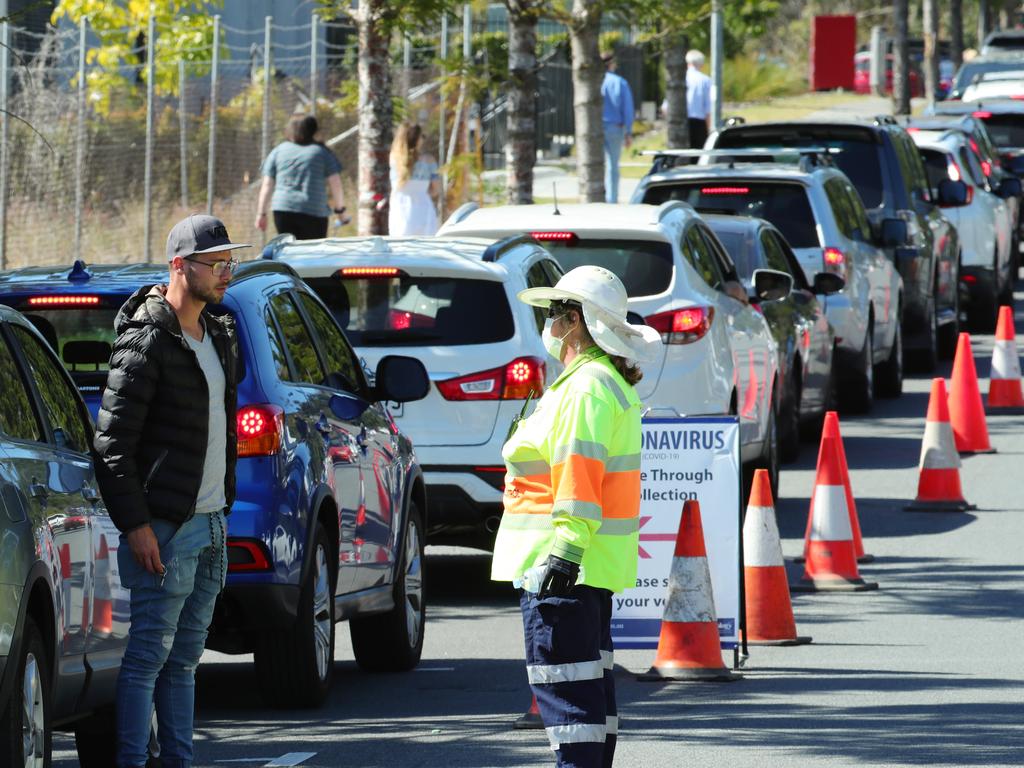Brisbane COVID cases: How authorities are tracking cluster link
As authorities race to find the missing link between coronavirus clusters at Logan and Brisbane’s youth detention centre, two possible culprits have emerged.
QLD News
Don't miss out on the headlines from QLD News. Followed categories will be added to My News.
Queensland’s latest coronavirus cluster may have been sparked by a yet-unidentified visitor to Brisbane’s Youth Detention Centre, or by a traveller who dodged hotel quarantine to again import the virus from interstate.
Both lines of inquiry are being pursued as authorities scramble to find a missing link between 10 cases from the detention centre and the Logan cluster after early genomic results showed the outbreaks were the same strain of COVID-19 and might be linked.
Kid criminals in semi-lockdown at Brisbane Youth Detention Centre
Qld coronavirus: Latest update on state’s COVID-19 status
Qld COVID cases: Consider wearing a mask if social distancing not possible
But The Courier-Mail can reveal authorities have not ruled out that the latest outbreak may have originated some other way, including via someone who recently returned from NSW or Victoria and lied about it.
The work comes as the state recorded no new cases yesterday.
But Queenslanders were issued a warning from Chief Health Officer Jeannette Young that if not every case could be found, hidden COVID-19 cases could start snaking their way through the community, sparking a second wave.
Genomic sequencing has shown that the 77-year-old supervisor at the detention centre has the same type of COVID variant – known as SARS-CoV-2 lineage B.1.1.25 – as the first positive case in the Logan cluster.
Olivia Winnie Muranga, a cleaner at Parklands Christian College in Park Ridge, infected a restaurant diner with the same COVID variant.
Her travelling companion, Diana Lasu, was infected by SARS-CoV-2 lineage B.1.36.
But the B.1.1.25 lineage has been common in NSW and Victoria since June, meaning authorities cannot categorically link the clusters yet.

As Dr Young awaits more detailed “high-resolution cluster analysis” that will assesses the genetic relatedness between sequenced cases, serology blood tests from the 10 current cases are exploring which case was the first. It’s thought the 77-year-old supervisor who first tested positive last week might not necessarily have been the first out of the 10 new cases to become sick.
Serology testing can show how advanced a person is in their illness, and hopefully identify which case came first.
That information would allow contact tracers to zero in on that person, and whether they can be linked back to the Logan cluster, which started when Muranga, Lasu and friend Haja Timbo returned from Melbourne, allegedly lied on their border declarations and did not isolate.
Contact tracers will be examining whether the Logan woman knew anyone in the youth detention centre, or anyone who visited there.
But Dr Young suggested there may still be an unidentified case in the community that linked the clusters together.
“It looks like this cluster has the same viral strain as one of the young women who went down to Melbourne,” she said.
“That doesn’t prove it, I need more information which is being done over the next 24 to 48 hours to be able to prove it.
“But at this stage it does look like they could be linked.
“But we don’t have the case between the two clusters.
“We’ve had the cluster related to that Melbourne-Logan group of those five people, and the cluster related to the Brisbane Youth Detention Centre – 10 people.
“There’s a missing link between the two, so that’s why it’s so important that we do our absolute best to find every single case because the cases we don’t find are the ones that can lead to chains of transmission.”
Dr Young said serology tests have been conducted on young people in the centre to find out if any of them previously had the virus and recovered.
And police have tracked down 91 of the 94 former youth detainees that have been released in recent weeks to test whether any of them were sick.
Dr Young said about 16 staff members who worked at the detention centre were still yet to be tested.

The search for the missing link comes as Queenslanders waited up to three hours at COVID-19 testing facilities and doctors brace for a surge in people seeking tests.
Assistant Health Minister Nikki Boyd told people to prepare for ong queues and delays and to bring snacks and water while she was at Pine Rivers Community Health Clinic yesterday, while others reported long delays at Gold Coast University Hospital.
Colin Paynter, 59, from Thorneside, yesterday queued at Murrarie’s QML Pathology drive-through testing facility for nearly three hours.
Although displaying no symptoms, he said he was being tested for work and to prevent infecting his elderly mother.
“She’s 84 years old and I’d hate to pass it on,” he said.
Royal Australian College of General Practitioners Queensland chair Dr Bruce Willett said GPs could expect to see a surge in people concerned about COVID-19 over the next couple of weeks.
Originally published as Brisbane COVID cases: How authorities are tracking cluster link



